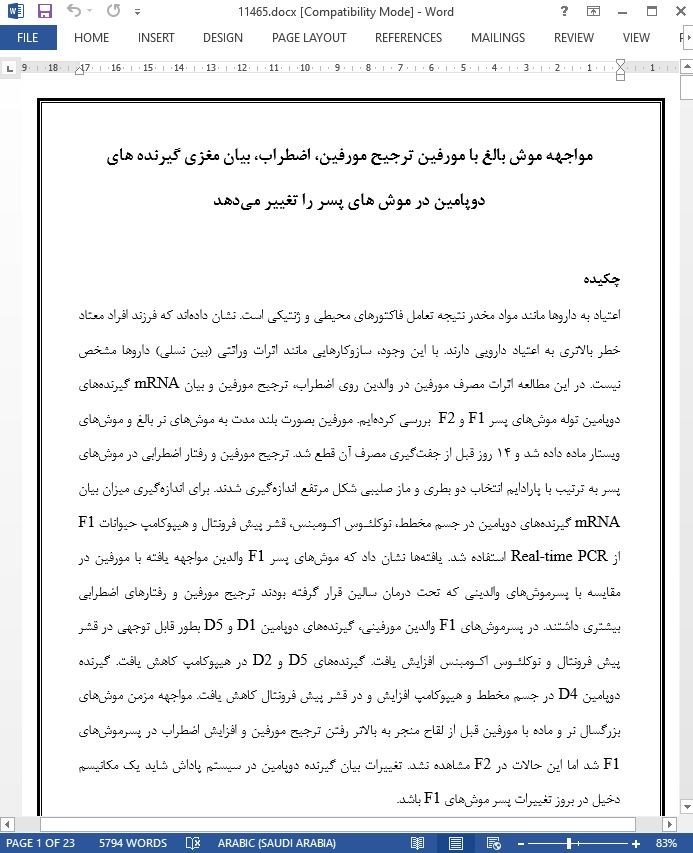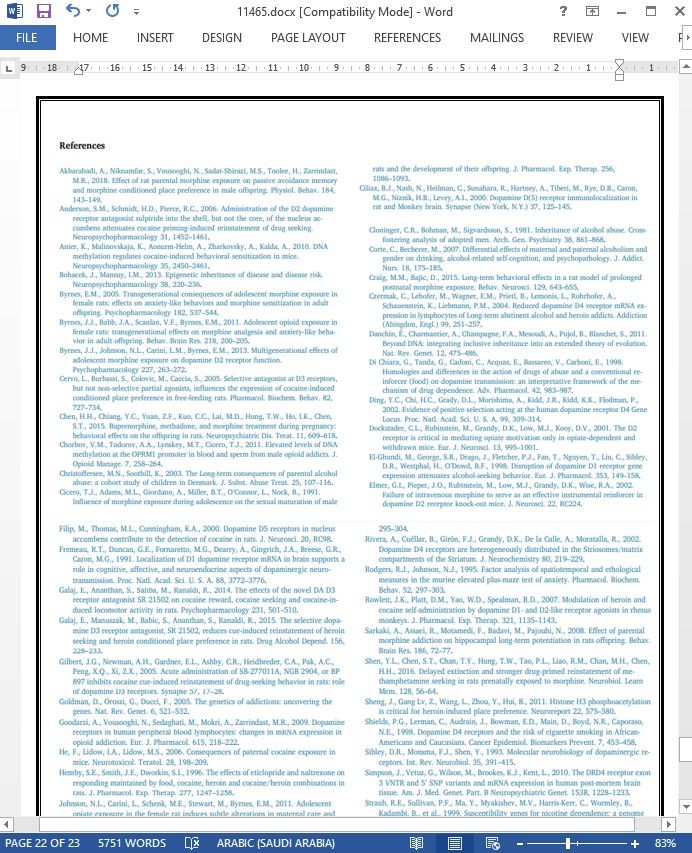
مواجهه موش بالغ با مورفین ترجیح مورفین، اضطراب، بیان مغزی گیرنده های دوپامین در موش های پسر را تغییر میدهد
چکیده
اعتیاد به داروها مانند مواد مخدر نتیجه تعامل فاکتورهای محیطی و ژنتیکی است. نشان دادهاند که فرزند افراد معتاد خطر بالاتری به اعتیاد دارویی دارند. با این وجود، سازوکارهایی مانند اثرات وراثتی (بین نسلی) داروها مشخص نیست. در این مطالعه اثرات مصرف مورفین در والدین روی اضطراب، ترجیح مورفین و بیان mRNA گیرندههای دوپامین توله موشهای پسر F1و F2 بررسی کردهایم. مورفین بصورت بلند مدت به موشهای نر بالغ و موشهای ویستار ماده داده شد و 14 روز قبل از جفتگیری مصرف آن قطع شد. ترجیح مورفین و رفتار اضطرابی در موشهای پسر به ترتیب با پارادایم انتخاب دو بطری و ماز صلیبی شکل مرتفع اندازهگیری شدند. برای اندازهگیری میزان بیان mRNA گیرندههای دوپامین در جسم مخطط، ﻧﻮﻛﻠﺌـﻮس اﻛـﻮﻣﺒﻨﺲ، قشر پیش فرونتال و هیپوکامپ حیوانات F1 از Real-time PCR استفاده شد. یافتهها نشان داد که موشهای پسر F1 والدین مواجهه یافته با مورفین در مقایسه با پسرموشهای والدینی که تحت درمان سالین قرار گرفته بودند ترجیح مورفین و رفتارهای اضطرابی بیشتری داشتند. در پسرموشهای F1 والدین مورفینی، گیرندههای دوپامین D1 و D5 بطور قابل توجهی در قشر پیش فرونتال و ﻧﻮﻛﻠﺌـﻮس اﻛـﻮﻣﺒﻨﺲ افزایش یافت. گیرندههای D5 و D2 در هیپوکامپ کاهش یافت. گیرنده دوپامین D4 در جسم مخطط و هیپوکامپ افزایش و در قشر پیش فرونتال کاهش یافت. مواجهه مزمن موشهای بزرگسال نر و ماده با مورفین قبل از لقاح منجر به بالاتر رفتن ترجیح مورفین و افزایش اضطراب در پسرموشهای F1 شد اما این حالات در F2 مشاهده نشد. تغییرات بیان گیرنده دوپامین در سیستم پاداش شاید یک مکانیسم دخیل در بروز تغییرات پسر موشهای F1 باشد.
1. مقدمه
اعتیاد به مواد مخدر مانند مورفین اختلالی مزمن است که بر مسیر مزوکورتیکولیمبیک دوپامینرژیک در مغز تاثیر میگذارد. در نهایت فعالسازی مسیر منجر به رهاسازی دوپامین در ﻧﻮﻛﻠﺌـﻮس اﻛـﻮﻣﺒﻨﺲ (NAc) (دی چیارا و همکاران، 1998) و تحریک گیرندههای دوپامین میشود. این گیرندهها در دو دسته اصلی قرار میگیرند: گیرندههای D1 مانند (D1 و D5) و D2 مانند (D2، D3 و D4) که هر یک از ژن متفاوتی تولید میشوند (سیبلی و همکاران 1993). فعالسازی گیرندههای دوپامینی D1- مانند D2- مانند به ترتیب باعث کاهش انگیزه یافتن پاداش و تسهیل خصوصیات تقویتی مواد مخدر اعتیاد آور میشوند (لی و همکاران، 2006).
5. نتیجهگیری
دادههای حاصل از این مطالعه نشان داد که مواجهه مزمن والدین با مورفین در موشهای بالغ قبل از لقاح منجر به ترجیح بالاتر مورفین و افزایش اضطراب در فرزندان پسر F1 میشود اما در F2 این چنین نیست. بیان این نکته حائز اهمیت است که مواجهه با مواد مخدر طی بارداری در حیوانات F1 وجود نداشت زیرا مصرف مواد مخدر در والدین دو هفته قبل از جفتگیری به صفر رسید. علاوه بر این، یافتههای ما نشان داد که تغییرات در مشخصات بیان گیرندههای دوپامین در مسیر پاداش ممکن است یکی از سازوکارهای دخیل در تغییرات مشاهده شده در حیوانات F1 باشد که میتواند عامل ابتلاء به سوء استعمال مواد مخدر در فرزند حیوانات مواجهه یافته با مورفین باشد.
Abstract
Addiction to drugs, including opioids is the result of an interplay between environmental and genetic factors. It has been shown that the progeny of addict people is at higher risk for drug addiction. However, the mechanisms of such trans-generational effects of drugs are not so clear. Here we have evaluated the effects of parental morphine consumption on anxiety, morphine preference, and mRNA expression of dopamine receptors in F1 and F2 male offspring. Morphine was chronically administered to adult male and female Wistar rats followed by 14-day abstinence before mating. Morphine preference and anxiety-like behavior in the offspring were measured by two-bottle-choice paradigm and elevated-plus maze, respectively. Real-time PCR was used to measure the mRNA expression level of dopamine receptors in the striatum, nucleus accumbens, prefrontal cortex, and hippocampus of F1 animals. The results indicated that F1 but not the F2 male progeny of morphine-exposed parents had a greater preference for morphine, and more anxiety-like behavior compared to the offspring of saline-treated parents. In F1 male progeny of morphine-treated parents, D1 and D5 dopamine receptors were significantly increased in the prefrontal cortex and nucleus accumbens. D5 and D2 receptors were decreased in the hippocampus. D4 dopamine receptor was augmented in striatum and hippocampus and decreased in the prefrontal cortex. Adulthood exposure to chronic morphine in male and female rats before conception leads to higher morphine preference and increased anxiety in F1 but not F2 male progeny. Alterations of dopamine receptor expression in the reward system may be one mechanism responsible for observed changes in F1 offspring.
1. Introduction
Addiction to opioids such as morphine is a chronic disorder that affects the mesocorticolimbic dopaminergic pathway in the brain. Activation of the pathway ultimately leads to dopamine release in the nucleus accumbens (NAc) (Di Chiara et al., 1998) and stimulation of dopamine receptors. These receptors are considered as two main categories: D1-like (D1 and D5) and D2-like (D2, D3, and D4) receptors, each of which is generated from a different gene (Sibley et al., 1993). Activation of D1-like and D2-like dopamine receptors decreases motivation to seek reward or facilitate the reinforcing properties of addictive drugs, respectively (Li et al., 2006).
5. Conclusion
The data of the present study revealed that chronic parental morphine exposure of adult rats before gestation results in higher morphine preference and increased anxiety in their F1 but not F2 male offspring. It is important to highlight that there was no gestational exposure to opioids in the F1 animals because parents were remained drug-free for two weeks prior to mating. Furthermore, our results showed that alterations in the expression profile of dopamine receptors in the reward pathway might be one of the mechanisms involved in observed changes in F1 animals, which could account for susceptibility to opioid abuse in the litter of morphine-exposed animals.
چکیده
1. مقدمه
2. عملیات آزمایش
2.1 حیوانات
2.2 مواد مخدر
2.3 روش آزمایش
2.4 آزمون ماز صلیبی شکل مرتفع (EPM)
2.5 ترجیح مورفین و مصرف
2.6 جمعآوری بافت مغز
2.7 استخراج کل DNA و رونویسی معکوس
2.8 پریمرهای PCR ریل تایم
2.9 PCR ریل تایم
2.10 تجزیه و تحلیل آماری
3. یافتهها
3.1 زنده ماندن توله موشها
3.2 اندازهگیری میزان استرس با آزمون ماز صیلبی شکل مرتفع (EPM)
3.3 ارزیابی جذب محلول مورفین
3.4 بیان گیرندههای دوپامین در PFC فرزندان
3.5 بیان گیرندههای دوپامین در NAc توله موشها (فرزند)
3.6 بیان گیرندههای دوپامین در هیپوکامپ فرزند
3.7 بیان گیرندههای دوپامین در استریاتوم
4. بحث
5. نتیجهگیری
ABSTRACT
1. Introduction
2. Experimental procedures
2.1. Animals
2.2. Drugs
2.3. Experimental design
2.4. Elevated Plus-Maze test (EPM)
2.5. Morphine preference and consumption
2.6. Brain tissue collection
2.7. Total RNA extraction and reverse transcription
2.8. Real-time PCR primers
2.9. Real-time PCR
2.10. Statistical analysis
3. Results
3.1. Litters survival
3.2. Measurement of anxiety level by elevated plus maze test (EPM)
3.3. Evaluation of morphine solution intake
3.4. Expression of dopamine receptors in the offspring's PFC
3.5. Expression of dopamine receptors in the offspring's NAc
3.6. Expression of dopamine receptors in the offspring's hippocampus
3.7. Expression of dopamine receptors in the offspring's striatum
4. Discussion
5. Conclusion
- اصل مقاله انگلیسی با فرمت ورد (word) با قابلیت ویرایش
- ترجمه فارسی مقاله با فرمت ورد (word) با قابلیت ویرایش، بدون آرم سایت ای ترجمه
- ترجمه فارسی مقاله با فرمت pdf، بدون آرم سایت ای ترجمه



